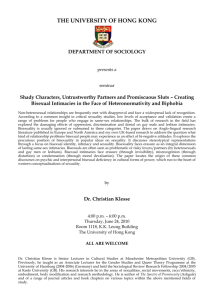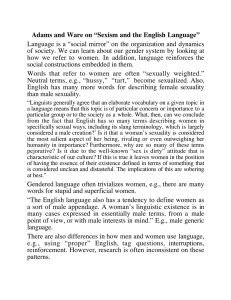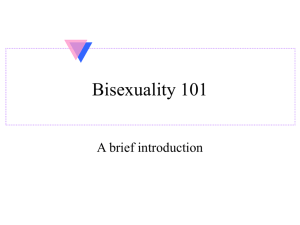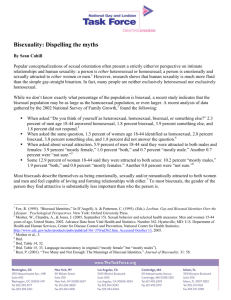:*6 Bisexuality Final Paper
advertisement
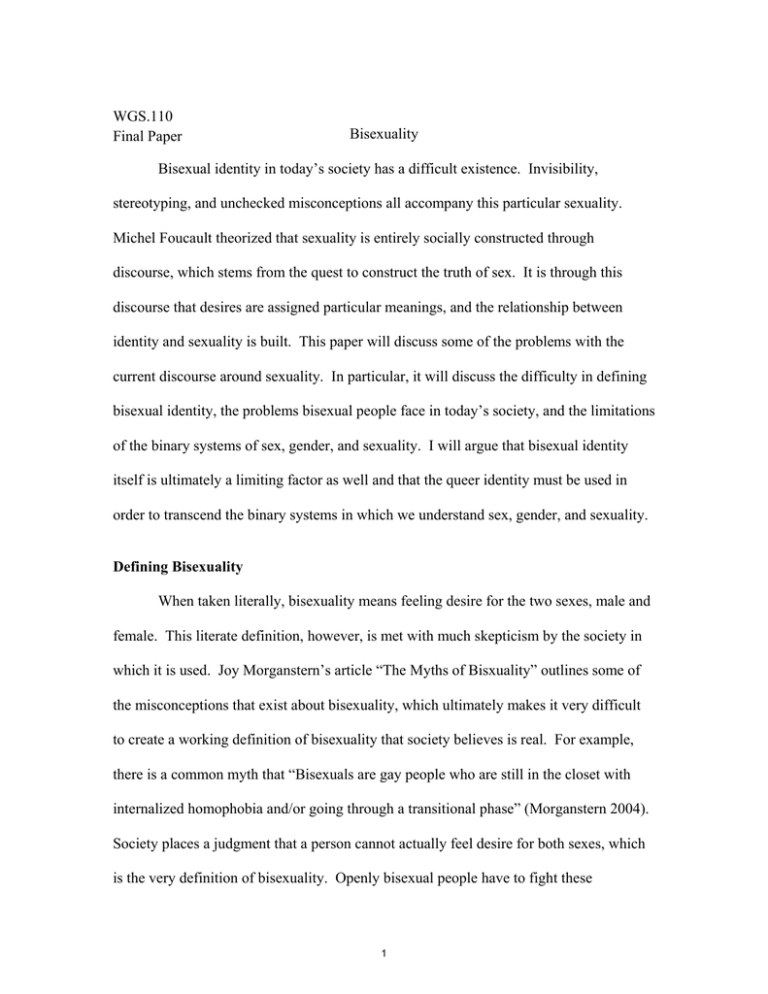
:*6 Final Paper Bisexuality Bisexual identity in today’s society has a difficult existence. Invisibility, stereotyping, and unchecked misconceptions all accompany this particular sexuality. Michel Foucault theorized that sexuality is entirely socially constructed through discourse, which stems from the quest to construct the truth of sex. It is through this discourse that desires are assigned particular meanings, and the relationship between identity and sexuality is built. This paper will discuss some of the problems with the current discourse around sexuality. In particular, it will discuss the difficulty in defining bisexual identity, the problems bisexual people face in today’s society, and the limitations of the binary systems of sex, gender, and sexuality. I will argue that bisexual identity itself is ultimately a limiting factor as well and that the queer identity must be used in order to transcend the binary systems in which we understand sex, gender, and sexuality. Defining Bisexuality When taken literally, bisexuality means feeling desire for the two sexes, male and female. This literate definition, however, is met with much skepticism by the society in which it is used. Joy Morganstern’s article “The Myths of Bisxuality” outlines some of the misconceptions that exist about bisexuality, which ultimately makes it very difficult to create a working definition of bisexuality that society believes is real. For example, there is a common myth that “Bisexuals are gay people who are still in the closet with internalized homophobia and/or going through a transitional phase” (Morganstern 2004). Society places a judgment that a person cannot actually feel desire for both sexes, which is the very definition of bisexuality. Openly bisexual people have to fight these 1 stereotypes as they go through the normal dating rituals that people of all sexualities experience. The definition of bisexuality has a difficult time maintaining legitimacy, because society assumes that feeling attraction for an individual or dating monogamously indicate homo or heterosexuality. Morganstern also further claries that “Just because some of us seem to be more attracted to women than to men, or vice versa, does not mean that we are not bisexual. Being bisexual does not mean that someone is exactly, equally attracted to both men and women. Some of us are more attracted to one sex, while some of us are equally attracted to both” (Morganstern 2004). As soon as it appears that a bisexual person is more attracted to one sex than the other, there is an instinct to mark that as a sign of hetero/homosexuality because of the skepticism that constantly surrounds bisexual identity. A preference for a sex is treated as an indication of the “true” sexuality. This need to classify desire agrees with Michel Foucault’s theories of sexuality. Some of his theories are discussed later in the paper, but society’s need to instantly categorize someone’s desire and find the meaning behind desire is a critical aspect. This assumption of hetero or homosexuality as the true sexuality cannot be overcome until there is more discourse on defining bisexual desire and constructing its meaning. The Visibility of Bisexuality Bisexuality is extremely difficult to distinguish because of the inherent conflict between sexual practice and sexual identity. Society most often judges one’s sexuality by looking at the sexual practices and seeing which sexual identity fits best contextually. Consequently, bisexual people are often judged as either heterosexual or homosexual. At a given moment, a monogamous bisexual person will be practicing either heterosexual or 2 homosexual practices but never both at the same time. While an individual may identify as bisexual, his or her practice will seem to indicate otherwise to society. It is difficult to look beyond the visible sexual practice and recognize that while it appears to match hetero or homosexuality, neither of those are actually the correct sexual identity. Morganstern’s article discusses the various incorrect stereotypes bisexual people have to face, some of which lead to the invisibility of this sexuality. At the end of the article she writes, "Sometimes the problem is just that we are invisible; when we're with someone of the opposite sex everyone assumes we're straight, and when we're involved with someone of the same sex everyone assumes we're gay" (Morganstern 2004). Because the homo/heterosexual identities are so much more visible than bisexual identity, they are automatically assumed before bisexual identity is considered. This lack of the bisexual visibility leads to a difficulty in creating discourse to link identity to sexuality. Another way of approaching the conflict of bisexual identity is through Freud’s distinction between sexual object and sexual aim. Unlike the homo or heterosexual identity, bisexuality has two object choices. And yet, the sexual aim is similar between all three sexualities. In fact, the sexual aim, or practice, of a bisxual person resembles that of either a heterosexual or a homosexual. While it is easy to define the sexual object as being either male or female, it is difficult to define the sexual aim of a bisexual. Disclosure Disclosure of one’s sexuality is an empowering act that the bisexual population does not have in today’s society. The relationship between disclosure and power is explored by Foucault in his The History of Sexuality. Foucault discusses how discourse around sexuality first began in the medical context with a patient discussing his or her 3 sexuality with the doctor. Private information about sex was made into private action through this act of confession. This confession of sex “...is also a ritual that unfolds within a power relationship, for one does not confess without the presence (or virtual presence) of a partner who is not simply the interlocutor but the authority who requires the confession, prescribes and appreciates it...” (Foucault 1978:61). Secrecy is lost and truth is exposed through these confessions, which remains “...the general standard governing the production of the true discourse on sex” (Foucault 1978:63). This exchange of knowledge and truth is ultimately a production and exchange of power between the confessee and the confessor leading to the constant construction and reconstruction of the truth of sex. Eve Sedgwick’s article Epistemology of the Closet discusses the contemporary implications behind disclosing one’s sexuality. The complex relation of this closet to society can be seen in Sedgwick’s statement, “I want to argue that a lot of the energy of attention and demarcation that has swirled around issues of homosexuality...has been impelled by the distinctively indicative relation of homosexuality to wider mappings of secrecy and disclosure, and of the private and the public...” (Sedgwick 1990:47). While the closet is indicative of homosexual oppression in our society, it is still a social construction that allows for the empowering act of public disclosure and visibility. It is a way to reinforce a particular, definable identity and take pride in it, which is critical to achieving liberation. There is no public discourse for the disclosure of bisexuality leading to much secrecy and lack of power. Kirsten McLean’s article “Living life in the double closet: Bisexual youth speak out” discusses the limitations of our current understandings of 4 sexuality and the difficulty in creates for those who identify with sexuality outside these two choices. McLean states, “Dominant public discourses endorse heterosexuality and homosexuality as legitimate sexual identities, but do not recognise that some people are neither exclusively heterosexual nor exclusively homosexual. The bisexual, encompassing certain elements of both heterosexuality and homosexuality, upsets the balance of such a binary...As such, bisexuality is positioned as the problematic `other,' and exists as an identity that lacks a clear definition” (McLean 2001). Disclosing one’s sexuality becomes complicated in this case, because the discourse is very negative and disclosure is not an empowering act of identification. There is more confusion than truth around bisexual identity in today’s society. The greater problem is the lack of a understood identity for bisexual people is that they must keep their sexuality a secret. Although they are in the closet, there is no positive way for them to come out and disclose their sexuality. In fact bisexual people are in a “`double closet,' where [they] maintain their bisexuality not by coming out of the closet, but by staying in it twice, `hiding their heterosexual activities from homosexual friends while hiding their homosexual activities from heterosexual friends’” (McLean 2001). Bisexual people face stigma from both the homosexual and heterosexual population. McLean’s article includes narrative from several bisexual youth and their experiences. She mentions the difficulty gay people face of creating a “straight” persona, and she continues that for bisexual people, “learning to hide means [they] frequently have three versions: a heterosexual version, a bisexual version and, often, a gay or lesbian version” (McLean 2001). They are hiding from both the heterosexual norm and the homosexual minority which is still an understood and acceptable sexuality in the binary 5 system. There exists enormous secrecy around bisexual identity with fewer chances for disclosure of this hidden information. In a study published in 1994 by Weinberg, Williams and Pryor, it was found that “bisexuals were less likely to be `out' than were homosexuals. Secrecy thus played a greater role in bisexuals' lives” (McLean 2001). Bisexual adolescents learn how to lie about their sexuality and become deceitful about who they really are because of the potential costs of disclosing their true sexual identity. There are many negative implications to this secrecy, starting with personal issues such as developing a healthy sexual identity. This ultimately leads to problems on the political front with establishing visibility, “Because...few young bisexual people are willing to act as community advocates, meaning that other young bisexual people also have few role models their own age to provide them with the encouragement to be proud about their sexuality, nor do they have peers with which to connect and discuss some of the issues they face in identifying as bisexual” (McLean 2001). There cannot be a bisexual movement before there is a public confession of one’s sexuality; unfortunately, the current discourse around bisexuality is negative and not conducive for disclosure. Problems Bisexuals Face As discussed above, bisexuals face a number of problems in today’s society because of a lack of an understood identity that is not comprised of simple stereotypes and blatantly wrong facts. This is particularly problematic for adolescents who are already aware of their sexual identity but only learn how to tell lies and keep secrets because of their fear of being “outed”. Not only is bisexuality not treated as a valid identity, the stereotypes associated with bisexuality are quite negative. 6 For example, there is a well accepted stereotype that “Bisexuals are diseaseridden sluts and/or greedy nymphomaniacs” (Morganstern 2004). Simply acknowledging the desire for either sex leads to potentially gaining the image of promiscuity. The minimal understanding that exists around having two object choices, as opposed to one, is not a genuine understanding of this dual desire. Along these lines, there is also a stereotype that bisexuals simply cannot make up their minds. They are seen as indecisive about their sexuality, because they have not chosen a single sexual object. Feeling desire for two sexual objects, to use Freud’s terminology, is not seen as valid. As mentioned previously, bisexuals face this discrimination from both the heterosexual and homosexual population. Although many bisexual people fight in the gay rights movement, the homosexual population remains as negative as heterosexuals when it comes to bisexual identity. This is particularly true from the lesbian population who see bisexual women as “traitors” to the lesbian feminist movement. McLean quotes a young woman as saying, “I still haven't told my lesbian friends. I'm scared they'll reject me because they don't really like bi women” (McLean 2001), which is sentiment shared by other young people in the article. Sheila Jeffreys also wrote a lesbian feminist critique, “Bisexual politics: A superior form of feminism?”, which takes a very negative view of the bisexual movement. Essentially, the entire article criticized the bisexual movement for how it hurt or detracted from the lesbian movement. The article displayed much animosity towards the bisexual population, which only makes things more difficult for those who identify as bisexual. While the situation has improved vastly for the homosexuals, bisexuals still face the discrimination that homosexuals faced not too long 7 ago. However, there is greater difficulty in achieving visibility and creating a strong identity for a movement. Non-Monogamy Non-monogamy is a non-trivial practice in the context of bisexuality. Given the tendency to be pitted as either “really” homo or heterosexual, non-monogamy is one relationship structure that gives people the opportunity to actually practice bisexuality. Polyamory, in particular, is the practice of having multiple committed relationships based on the idea that it is not only possible, but more fulfilling, to love more than one person at a time. This is similar to a sentiment expressed by Morganstern that “For most [bisexuals], bisexuality represents openness to loving both men and women, not a compulsion to do so every night” (Morganstern 2004). Both polyamory and bisexuality share the idea of feeling desire and/or love beyond the one individual, may that be through one relationship or one sex. They also both deviate substantially from the normative sexual practices of heterosexual monogamy, making it even easier situation for the two groups to overlap. Ultimately, non-monogamy offers a legitimate way for bisexuals to have their practice line up with their identity. Non-monogamy is a sexual aim that is that can visibly match the bisexual object choices, instead of looking like the hetero or homosexual aim. More importantly, it is a framework for which bisexual identity can be understood. For bisexuals, non-monogamy bridges the gap between sexual practice and identity, bringing visibility to a sexuality that usually remains otherwise hidden. One does not imply the other; it is simply an opportunity to have continuity between practice and desire. 8 Binary Systems Critical to understanding the misunderstandings of bisexuality is discussing the binary systems of sex, gender, and sexuality. The heterosexual presumption and then the homosexual presumption over bisexuality, the lack of a clear identity, and the constant push to be either hetero or homosexual stems from the binary systems. Society has constructed two sexes, male and female, two genders, masculine and feminine or man and woman, and two understood sexual identities, heterosexual and homosexual. The normative is alignment of sex and gender and feeling desire for the opposite sex and gender. The current understandings of homosexuality only accounts for feeling desire for the same sex and the possible inverted relationship between sex and gender. Only recently has homosexuality begun to be treated as an acceptable sexuality; however, this acceptance stems from the idea that homosexuality is an imitation of heterosexuality. Essentially, homosexuality is being integrated into society in context of its similarities to the heterosexual norm, and the fundamental ways in which we think about sexuality are not changing. Society has simply made homosexuality fit within our current binary systems of sex and sexuality, where heterosexuality is the norm and homosexuality is just a crossing of the lines. In fact, it is the model of the heterosexual norm, which also leads to acceptance of the effeminate gay male and the butch lesbian female. These inversions of sex and gender only help the homosexual relationship fit the heterosexual norm, because now the only deviation is the same sex desire. The binary understandings of xex and gender, which are a key part in our current ideas of sexuality, explain why society has such difficulty has in grasping anything outside of the homo/hetero dichotomy. 9 Defining and understanding a sexuality is based on the binary systems of sex and gender, which leaves no room for anything besides the hetero or homosexual identity. Unfortunately, the bisexual label itself purpetuates this hetero/homo dichotomy. Instead of desiring one sex, there is desire for both sexes. The prefix “bi” literally means two, which keeps the bisexual population locked into the current binary systems of sexuality. It are these same systems that also prevent them from being accepted and understood by society. One adolescent is quoted in McLean’s article as saying, “One of the problems I found in coming to terms with my bisexuality was that it still seems to say in its language that you're both gay and straight” (McLean 2001). While acceptance of homosexuality does not indicate a more evolved and fuller understanding of sexuality, the bisexual label and possible acceptance of the identity also do not necessarily imply revolution in the ways in which we think about sexuality. Sexuality remains locked within the confines of a duality, tied closely to the notion of sex. Queer Identity The bisexual label and identity also remains a relatively limiting identity because it does not break any of the bonds between sex and gender. The normative gender for the male sex remains masculine and vice versa. None of the normative relationships between sex and gender are changed with bisexuality indicating more limitations to come in the future when creating sexual identities. There will be true freedom in object choice only when the relationship between sex and gender no longer exists. Otherwise, the discourse will always create a normative sexuality, one where sex and gender align, and a deviant sexuality, one which involves other relationships between sex and gender. 10 The queer label and identity is one that makes no reference to the existing binary systems nor any of the existing relationships. It is a label that offers freedom of object choice that is unrelated to one’s sex, and it can also be used to refer to one’s gender identity in relation to sex. Stephen Valocchi’s article “NOT YET QUEER ENOUGH: The Lessons of Queer Theory for the Sociology of Gender and Sexuality” discusses queer theory and how it pushes the “...monographs in an even "queerer" theoretical direction. This direction involves taking more seriously the nonnormative alignments of sex, gender, sexuality...” (Valocchi 2005). Queer theory rethinks all of the existing binary ideas pertaining to sex, gender, and sexuality, which is the direction society must move towards because “...the binaries are revealed to be cultural constructions or ideological fictions, the reality of sexed bodies and gender and sexual identities are fraught with incoherence and instability” (Valocchi 2005). The bisexual label, as unaccepted as it is in today’s culture, still does not fundamentally change the discourse around sexuality and the truth of sex that has been constructed. Conclusion Defining bisexual identity is a difficult task within societal constructs about sex, gender, and sexuality. In line with Foucault’s theories of sexuality, society is in a constant quest for the truth of sex which is constructed through discourse. However, the discourse that exists today only recognizes hetero and homosexuality as true sexualities, seen by the numerous stereotypes that reinforce the ideas that bisexuality is not a “real” sexuality. It is inherently difficult to make bisexual practice visible in the monogamous context, because the practice always appears to either be hetero or homosexual. This 11 prevents the develop of discourse necessary for creating the relationship between an identity and sexuality. Furthermore, the negative stereotypes that exist about bisexuality make it a difficult place for people to publicly disclose their sexuality. Bisexuality remains a secret, taking away a major source of empowerment for the bisexual population. There is no unified identity that can be used to gain a political front, which only exacerbates the problem of invisibility that bisexuals face. Non-monogamy is one legitimate method for bisexuals to visibly practice their sexual identity. They can be involved with people of both sexes, preventing the hetero or homosexual presumption. It is easier to accept that bisexual people feel desire for both sexes, if they are visibly involved in such a practice. Non-monogamy is an empowering practice for bisexuals, because it leads to disclosure of one’s sexuality that would otherwise have remained hidden. Bisexual identity is difficult to understand, and consequently, define, because of the current binary constructs of sex, gender, and sexuality. More importantly, these three entities are so intertwined with each other that one cannot be understood without the others. Sexuality is understood in terms of desiring the same or opposite sex, with heterosexuality being the normative and homosexuality being the imitation. Genders are also assigned to sex, masculine to men and feminine to women, which are then reversed in homosexual relations to further fit the heterosexual norm. Bisexuality does not fit the notion of desiring either the same sex or opposite sex, leading to all of the stereotypes and misconceptions about bisexual identity. 12 Part of the problem is the bisexual label itself, which is based on the binary system that limits them. The label still assumes two sexes, the only difference being the desiring of both, as opposed to one. In order to truly change the discourse around sexuality and reconstruct the truth of sex, the queer identity must be used. Only then are the binary systems of sex, gender, and sexuality dismantled. More importantly, the construed relationships between them will also be broken, allowing for true freedom of sexual desire and practice. Sexual desire will simply be about the individuals involved, not characteristics such as their sex and gender, which are ultimately unnecessary in defining sexuality. 13 MIT OpenCourseWare http://ocw.mit.edu WGS.110 Sexual and Gender Identities Fall 2010 For information about citing these materials or our Terms of Use, visit: http://ocw.mit.edu/terms.
